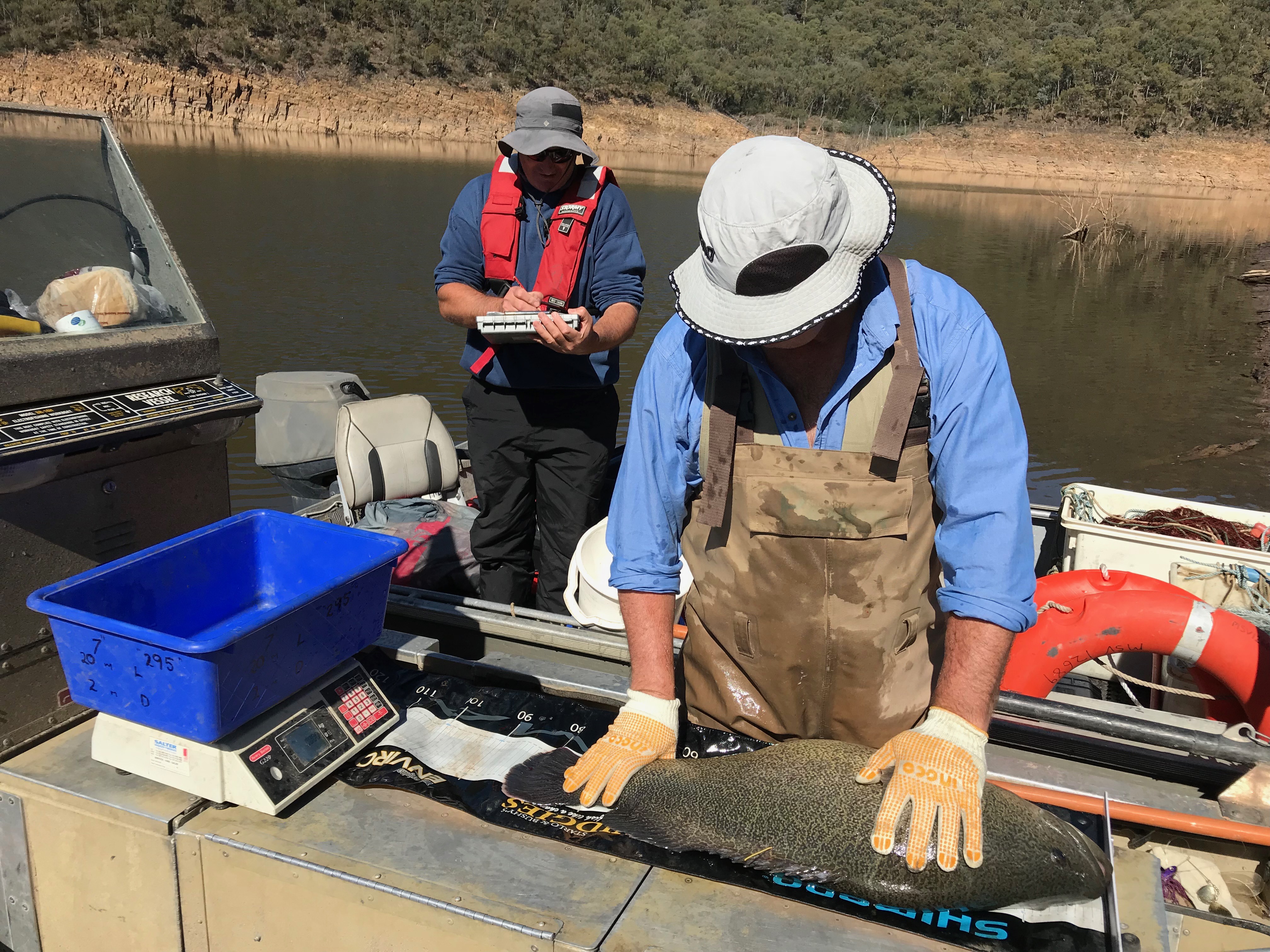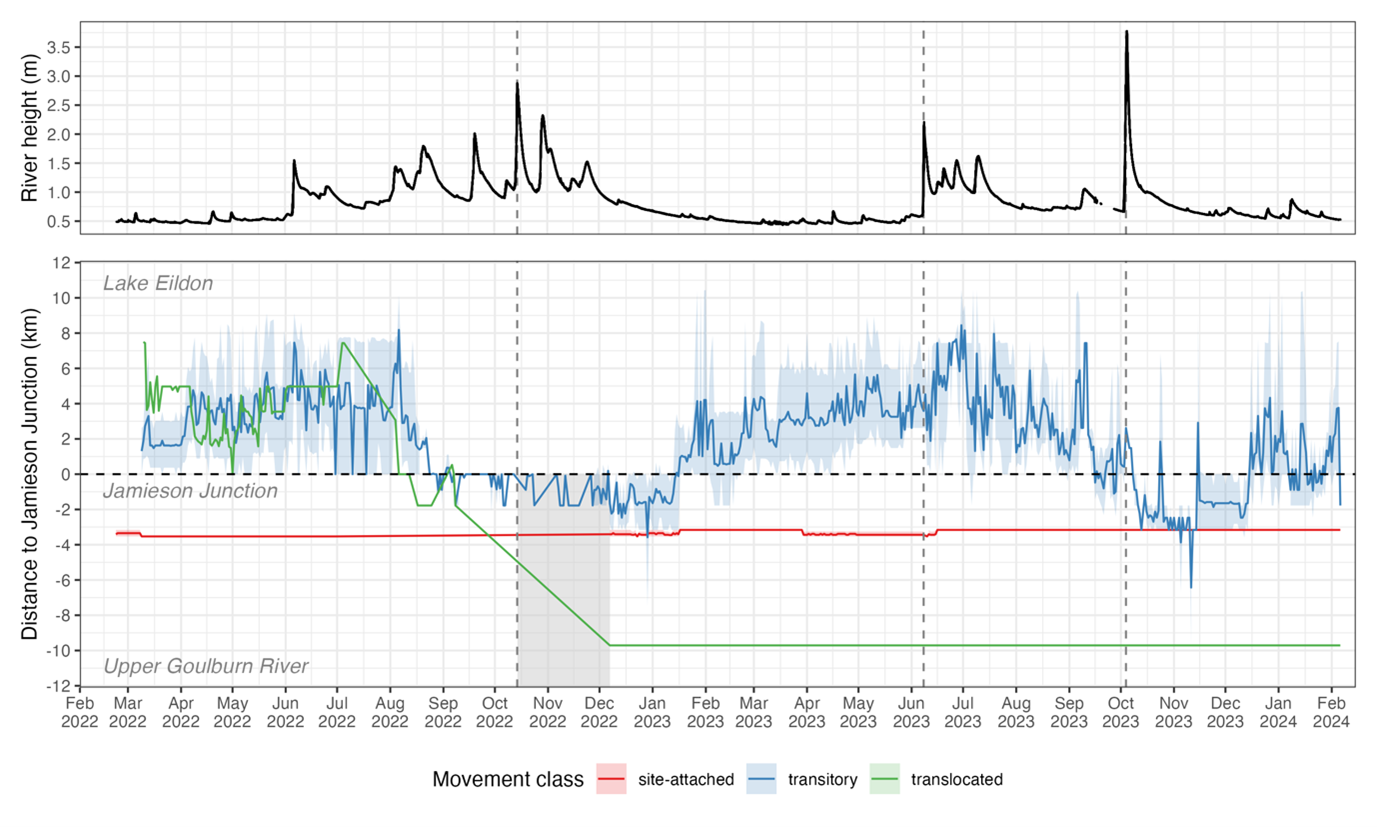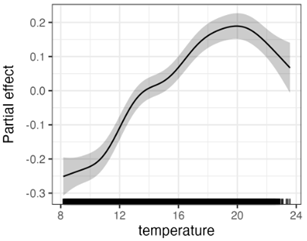Murray cod movement - Upper Goulburn River

Unlocking the secret life of Murray cod
Victoria is home to one of Australia’s best Murray cod fisheries, Lake Eildon. Thanks to the stocking of around 5.5 million cod fingerlings since 1990 by the Victorian Fisheries Authority (VFA), fish of all sizes are targeted and caught by recreational anglers. Today, the lake has a growing reputation to hold trophy size Murray cod with some fish as large as 130 cm.
To help recreational anglers make the very most of this amazing year-round fishery and increase their chances of catching one-metre plus sized cod, the VFA has just completed some fascinating research about the movement and habitat preferences of Murray cod in the Upper Goulburn River and Lake Eildon.
The findings will give lure casters and bait fishers alike valuable insights into how best to target the lake’s cod population and increase their chances of landing that fish of a lifetime!
The research
Nineteen Murray cod averaging 93 cm (66 cm – 113 cm) in length were caught in 2022 – 2023, fitted with electronic acoustic tags and released in the Jamieson arm of Lake Eildon and the Upper Goulburn River. Sixteen acoustic receivers covering 32 km of lake and river were used to ‘listen’ for any electronically tagged fish swimming within 300 m. The tags transmit data to the receivers such as fish number, date, time, depth, temperature and acceleration which were routinely downloaded and analysed.
1.5 million data records were captured over a two-year period; coupled with environmental data it revealed fascinating results.
In Lake Eildon you can catch Murray cod all year round - but where/when are they most active?
| Where | Summer: Winter: |
| Time of day | Summer: Winter: |
| Depth | Summer: Winter: |
| Water temperature when most active | 16°C - 23°C (ideal is 20°C) |
| Water levels when most active | When water levels are stable with little run off |
| Air pressure when most active | Air pressure <1000hPa |
Summary of Results - Dr Corey Green at Murray Codference 2025
Detailed Results
Movement in the lake and river:
Three different types of movement characteristics were observed in Murray cod. Most fish were ‘transitory’ (i.e. they are constantly moving to different locations) while other were site-attached (i.e. fish that stayed in the same location). Interestingly one fish was caught some 10 km upstream from Jamieson and released at the Jamieson boat ramp in Lake Eildon. It was later observed back at the location it was originally caught some 9 months later.
Tagged Murray cod displayed clear seasonal patterns in their use of Lake Eildon, aligning with known ecological behaviours of the species. Movements in relation to the Jamieson Junction (i.e. where the Jamieson and UGR meet) highlighted cyclic patterns of ‘transitory’ individuals moving into Lake Eildon, with movements into the Upper Goulburn River observed closely after the first flood events between August and October, aligning with seasonal patterns in spawning.

Tagged cod revealed cyclic patterns in movements in both lake and river systems across the calendar year, with individuals moving into and occupying space within the Lake between February – August and moving back upstream into the Jamieson Junction and the Upper Goulburn River in summer (September – January).
Some Murray cod were highly active moving (upto 1750 km) while others preferred their surroundings and stayed where they were released.
Preferred depth:
The figure below is a coloured representation of a Murray cod’s depth preference (light green signifies shallow water <1 m, dark blue signifies deep water 8 m) by month (horizontally) and hour of the day (vertically).
Findings suggests that cod prefer deeper waters during the middle of the day and in cooler months (blue and green boxes); and shallow waters during the warmer months. This preference of shallow waters during warmer months likely is attributed to them moving up in the shallow waters of Lake Eildon’s arms and tributaries and possibly associated with their natural spawning characteristics.

For cod that spent majority of their time in Lake Eildon were found to be:
- Deeper in the cooler months (Especially during the day)
- Shallower in the warmer months
Acceleration:
Acceleration in Murray cod can be indicative of their response to hunting and feeding on prey. The figure below is a coloured representation of a Murray cod’s acceleration (Red fast, Blue slow) by month and hour of the day.
It suggests that they are more active during the warmer months (red boxes) compared to periods during the cooler months (blue box). It also suggests that fish are mostly active from dusk till dawn (green boxes).

Outputs form models suggest that Murray cod are most active when the water temperature is around 20°C .
Some anglers believe that fishing during full or new moons increases likelihood of catchin g Murray cod however our research indicated that there was no correlation between acceleration and moon phase.

More Information
The two-year project is a great example of applied research to unlock secrets and bust myths about Murray cod, their habits and their movements. A scientific paper is in preparation that details full results.
For more information please contact the VFA's Corey Green via email.
